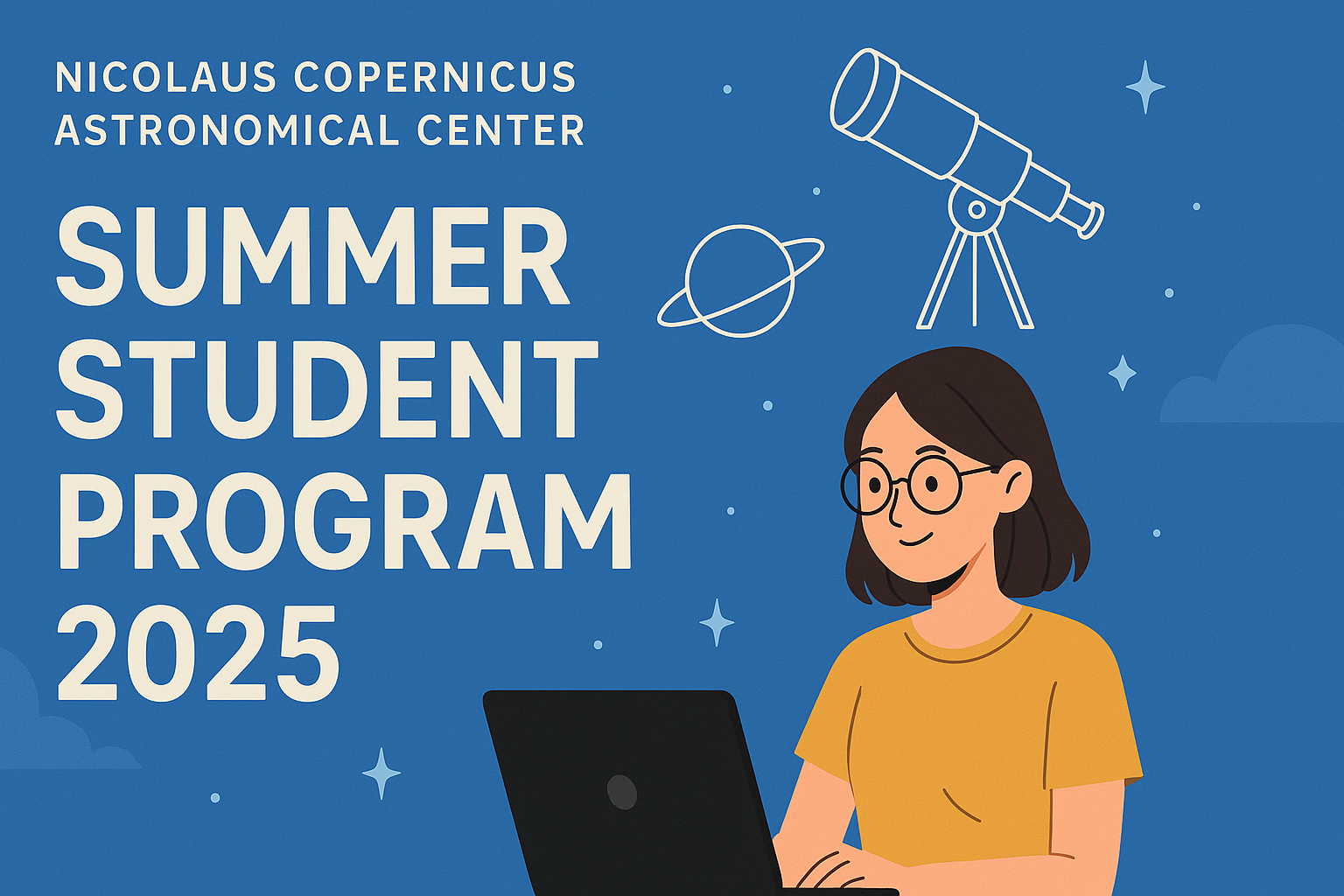Recruitment has been completed

As part of our long-standing tradition, the Nicolaus Copernicus Astronomical Center will organize the 2025 Summer Student Program in a hybrid format. This means that students will have the opportunity to work on projects either on-site at the CAMK institute or remotely. On-site participants may be accommodated in Warsaw dormitories, depending on availability. The exact mode of collaboration is determined by the project supervisor and specified in the project description. For on-site projects, the supervisor is expected to be available in person. An online-only option is also possible.
We invite applications from 2nd, 3rd, or 4th-year undergraduate students in physics or astronomy (exceptionally, younger students may be considered). The duration of each individual internship is expected to be between 4 and 6 weeks. Suggested project topics are listed below.
If you are interested in participating in an online-only internship, please contact the selected supervisor directly to arrange the details. For on-site participation, contact the supervisor first to confirm the project dates and duration, then submit your application - including the supervisor’s name, project dates, and your scientific CV - in PDF format to praktyki@camk.edu.pl.
There is no formal application deadline; applications will be reviewed on a rolling basis. Selected candidates will be notified by email. Please note: the on-site option is available only to EU citizens.
Pojects
1. Supervisors: Debora Lancova and Miljenko Cemeljic, email: miki@camk.edu.pl
Title: Radiative MHD simulation of thin disc
Time: 2 + 2 weeks on site, discussions in between online, weekly meetings.
First week: Intro to MHD & PLUTO.
Second week: Simulation set-up and testing.
Third week: Analysis of results.
Fourth week: Comparison to observed sources.
First: June 16th onward. Second: August 11th onward Project for CAMK Summer Program July/Sep 2025, on-site form
Project description: The project aims to simulate a radiation-pressure-supported thin accretion disk using the magnetohydrodynamic (MHD) code PLUTO, a state-of-the-art numerical tool for modelling astrophysical plasmas. Such disks are believed to form in high-accretion-rate systems, such as Young stellar object or binaries with white dwarfs, neutron stars andblack holes, where the pressure from radiation becomes comparable to or even dominates over gas pressure. The primary goal is to explore the stability of these disks under different physical conditions, such as varying magnetic field configurations or levels of radiation pressure. The simulations will help us understand whether these disks remain stable or develop instabilities, which can lead to turbulence, outflows, or changes in the disk structure. The student will learn how to configure and run 2D or 3D simulations using the PLUTO code, run simulations on a supercomputing cluster, gaining hands-on experience with high-performance computing, post-process the results and visualize physical quantities, compare the disk properties and stability outcomes with theoretical expectations and observational data from real astrophysical systems.
Workplan: After a fast-forward introduction to simulations with PLUTO code, student(s) will embark on setting-up the simulation and test the numerical stability. They will also learn the theoretical basis of MHD and use numerical methods. After running the simulations, student(s) will analyze the data and discuss the results.
Audience: undergrads and early-stage PhDs with interest and at least some knowledge of coding and work in Linux, C & Python.
2. Supervisors: Miljenko Cemeljic, Tanja Kaister & Sukalpa Kundu, email: miki@camk.edu.pl
Title: CAMK small radio telescope
Time: between 15.06-25.08.2025
Form: on-site, Location: CAMK, Warsaw
Project description: Two years ago we started developing CAMK small radio telescope, based on low-cost Software Defined Radio (SDR) technology. We observed the neutral hydrogen line in our Galaxy (see https://users.camk.edu.pl/miki/csrt.html), and will now extend our capabilities with the use of additional, larger parabolic antennas available in CAMK and acquiring radio signals from the Sun and Jupiter.
Audience: In addition to usual pool of participants like University students, we also accept motivated high-school students for shorter visits and hands-on experience. It is unique opportunity to gain insider experience in research environment in the prime astronomical institute in Poland!
3. Supervisors: Krzysztof Nalewajko, Wen Xuan Sia, email: knalew@camk.edu.pl
Title: GRMHD numerical simulations of BH accretion and formation of relativistic jets
Time constraints: the preferred time is Jul 14th - Aug 14th in Warsaw, with the option to continue online
Project description: We offer an introductory project to general relativistic magnetohydrodynamical (GRMHD) numerical simulations of accretion onto Kerr black holes (BH) and formation of relativistic jets. Numerical codes, analysis scripts, access to computing facilities, astrophysical background will be provided and explained. Knowledge of computing, numerical methods, fluid dynamics, magnetism or general relativity will be preferred.
4. Supervisor: Sergen Özdemir, John Eduard Martínez Fernández & RodolfoSmiljanic, email:sergen@camk.edu.pl
Title: Investigation of globular cluster stars in spectroscopic surveys
Time: Starting at early or mid-August (4 weeks)
Project description: The chemistry of Galactic globular clusters is really important to understand the formation of our Galaxy. Recent spectroscopic surveys have published unprecedented catalogs of parameters and abundances of stars belonging to Galactic globular clusters. However, globular clusters are still full of unknowns and exhibit interesting features like multiple populations. In this study, we will dive into survey catalogs to investigate the chemistry of globular clusters (e.g., Gaia-ESO Survey, GALAH). The student will have a chance to get familiar with and use different unsupervised machine learning algorithms (e.g., hierarchical clustering, K-means, etc.) to identify stars that have different chemical signatures than other cluster stars. We will discuss potential explanations for the formation of those stars.
Work Plan: First week, the student will be given a basic introduction to stellar evolution and globular clusters. Second week, different spectroscopic surveys and machine learning algorithms will be introduced to the student. Third and fourth weeks, the student will apply different machine learning algorithms to the survey data and perform further tasks that will include the interpretation of the findings. At the student's request to continue the project, we may extend the duration of the internship. Outcomes of the project: The student will learn how to use and interpret catalog data and useful tools in data analysis and processing (e.g., TOPCAT, different Python packages). The student will have knowledge about stellar evolution, globular clusters, and their chemical properties.
Requirements: Basics of Python and knowledge of statistics.
5. Supervisor: Marek Abramowicz marek.abramowicz@physics.gu.se
Title: Do the primordial black holes exist?
Time: July 1 — September 15, 2025,
Supervision by Marek Abramowicz on-site in Warsaw, consultation with Dr Przemek Mróz from the OGLE team on-site in Warsaw, for a successful student two additional weeks working with Dr Maciek Wielgus at the Instituto de Astrofísica de Andalucía, Granada, Spain, paid by Dr Wielgus’ grant.
Project description: Research on answering the question of fundamental importance for physics: do the primordial black holes exist? Our approach is based on the argument that if they do, they must collide with neutron stars, resulting in the formation of light black holes LBH, with masses of the order of 1 M_Sun, which are detect the OGLE program. The population synthesis code described in reference [4] needs to be slightly changed and improved.
The student's work will concern on two problems:
1. Theory: calculation of the expected number of LBHs using the improved code.
2. Observations: number of LBH detected by OGLE
The program will start with my intense introductory course on the subject, which would
explain to the student in detils important issues from the literature of the subject (theory):
Literature:
Theory
[1] No observational constraints from hypothetical collisions
Hypothetical primordial black holes with dark haloes with galactic objects
https://ui.adsabs.harvard.edu/abs/2009ApJ...705..659A/abstract
[2] Dynamical friction in a gas medium
https://ui.adsabs.harvard.edu/abs/1999ApJ...513..252O/abstract
[3] Primordial black holes captured by neutron stars: Simulations
in general relativity
https://ui.adsabs.harvard.edu/abs/2024PhRvD.110b3021B/abstract
[4] Robust test of primordial black holes in galactic dark matter halos
https://ui.adsabs.harvard.edu/abs/2022ApJ...935L..28A/abstract
Observations
[5] Constraints on planetary-mass primordial black holes from OGLE
High-through put survey of the Magellanic Clouds
https://ui.adsabs.harvard.edu/abs/2024ApJ...976L..19M/abstract
[6] No massive black holes in the Milky Way halo
https://ui.adsabs.harvard.edu/abs/2024Natur.632..749M/abstract
Requirements: some knowledge of programming, enthusiasm for scientific work
6. Supervisor: Grzegorz Pietrzyński, pietrzyn@camk.edu.pl
Title: Measuring Cosmic Distances
Supervisors: Grzegorz Pietrzynski, Piotr Wielgórski, Gergely Hajdu
Time: July/Sep 2025
Project description: Modern physics is unable to explain independent determinations of the expansion of the Universe. This problem called the Hubble tension provide a strong evidence for new physics. In order to solve the Hubble tension and eventually pave a road for new physics one has to measure cosmic distances with much better precision and accuracy. Cosmic distances are one of the most challenging and fascinating fields of modern astrophysics. The international team called the Araucaria works on this topic since 2020 (https://araucaria.camk.edu.pl/).
We offer an introduction to the topic and a possibility to join one of the projects, which include pulsating stars (Cepheids, RR Lyrae, ect), eclisping binaries, TRGB, JAGB, and other distance indicators. This project may include observations in our dedicated observatory in Chile.
Requirements: basic knowledge of astrophysics, programming and computer skills






